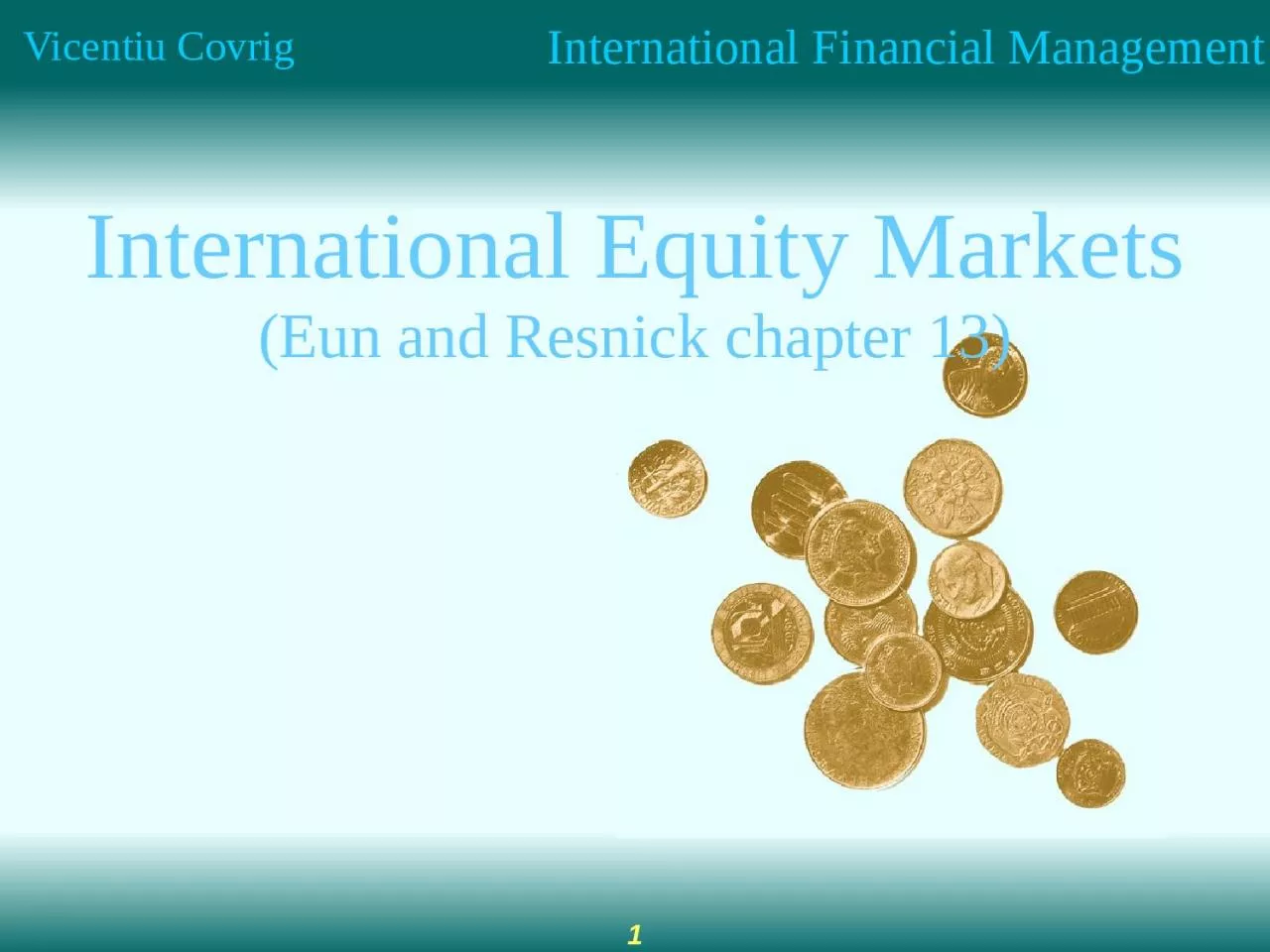

Eun and Resnick chapter 13 Developed vs Emerging Markets Factors that are used to classify the worlds financial markets in developed and emerging markets the size and scope of the equity fixed income and derivatives markets ID: 1029560
Download Presentation The PPT/PDF document "International Equity Markets" is the property of its rightful owner. Permission is granted to download and print the materials on this web site for personal, non-commercial use only, and to display it on your personal computer provided you do not modify the materials and that you retain all copyright notices contained in the materials. By downloading content from our website, you accept the terms of this agreement.
1. International Equity Markets(Eun and Resnick chapter 13)
2. Developed vs Emerging Markets Factors that are used to classify the world’s financial markets in developed and emerging markets: the size and scope of the equity, fixed income and derivatives markets the sophistication of the local market professionals liquidity and transaction costs quality and quantity of financial information financial regulations, business laws, ethics, investor protection
3. Market CapitalizationAlmost 80% of the total market capitalization of the world’s equity markets is accounted for by the market capitalization of the developed worldStandard & Poor’s Emerging Markets Database classifies a stock market as emerging if it meets at least one of two general criteria:It is located in a low- or middle-income economy as defined by the World Bank.Its investable market capitalization is low relative to its most recent GNI figures.
4. Risks of investing in international markets sovereign (political) riskSovereign governments have the right to regulate the movement of goods, capital, and people across their bordersin general, financial managers and investors incorporate a political risk premium when foreign activities are being evaluatedEx: ethnic strife in Indonesia; currency controls in Malayasia; expropriation in Africa and Central America; changes in taxes and regulations;
5. Risks of investing in international marketsliquidity risk: refers to how quickly an asset can be sold without a major price concession- The equity markets of the developed world tend to be much more liquid than emerging marketsEmerging markets have limited investability- Emerging markets tend to be much more concentrated than our markets.That is, a few issues account for a much larger percentage of the overall market capitalization in emerging markets than in the equity markets of the developed world.
6. Risks of investing in international marketsInformation risk: most investors prefer to invest in assets that are more familiar with foreign language limited access to information lack of disclosureunfamiliar accounting system
7. Risks of investing in international marketsForeign Exchange Risk- Foreign operations are conducted in foreign currencies.- When firms and individuals are engaged in cross-border transactions they are exposed to foreign exchange (FX) risk. - The foreign currency profits, costs, revenues in dollar terms depends on exchange rate movements.- FX risk affects the cost of capital and the capital structure of a MNC firm- Capital budgeting decisions are more complex in the international context
8. Trading in International EquitiesDuring the 1980s world capital markets began a trend toward greater global integrationDiversification, reduced regulation, improvements in computer and communications technology, increased demand from MNCs for global issuance.Cross-Listing refers to a firm having its equity shares listed on one or more foreign exchanges.Foreign stocks often trade on U.S. exchanges as ADRs.It is a receipt that represents the number of foreign shares that are deposited at a U.S. bank.The bank serves as a transfer agent for the ADRs
9. Advantages of Cross-ListingIt expands the investor base for a firm.Very important advantage for firms from emerging market countries with limited capital markets.Establishes name recognition for the firm in new capital markets, paving the way for new issues.May offer marketing advantages.May mitigate possibility of hostile takeovers.
10. American Depository ReceiptsThere are many advantages to trading ADRs as opposed to direct investment in the company’s shares:ADRs are denominated in U.S. dollars, trade on U.S. exchanges and can be bought through any broker.Dividends are paid in U.S. dollars.Most underlying stocks are bearer securities, the ADRs are registered.
11. American Depository ReceiptsThere are four levels of ADRs:Level I: - trade over-the-counter (OTC) pink sheets - minimal SEC disclosure; no GAAP complianceLevel II: - exchange-listed securities; without capital raising - extensive SEC disclosure; partial GAAP reconciliationLevel III: - exchange-listed securities; capital raising - full SEC disclosure; full GAAP reconciliationRule 144A: - capital raising issues sold to qualified institutional buyersLevel I 55%; 144A: 23%; levels II and III 22%
12. North American Equity Market Benchmarks
13. European Equity Market Benchmarks
14. Asia/ Pacific Rim Equity Market Benchmarks
15. Learning outcomes:discuss the characteristics that differentiate the developed from emerging markets discuss the following risks of investing in international markets: sovereign, liquidity, foreign exchange , information Know what is/are: primary market; secondary market; market order; limit order; dealer market; over-the-counter market; explain what is an ADR and why investors invest in them Discuss the factors affecting international equity returnsEnd of chapter questions 2, 3, 4, 6; problem 1